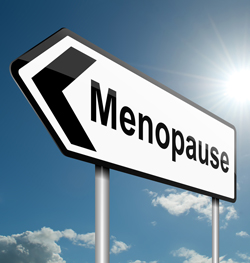You have no items in your shopping cart.
Problems Adding to Cart? Click here for assistance.

Women enter menopause between the ages of 40 and 58. Menopause is defined as the day a woman has been diagnosed as not having a menstrual period for 12 consecutive months. For me that was when I was 51; for the average American woman, menopause strikes at the age 46. Changes to mood, weight, energy levels and skin are, of course, in evidence years before and for years after. And it comes down to estrogen.
Estrogen is a powerful hormone and the effects when its levels change are far-reaching. Plummeting levels of estrogen and the changed ratios of the different hormones in your body will affect your skin and hair dramatically. Estrogen impacts collagen, moisture and hair growth. The good news is that we no longer have to whisper as though menopause was a dirty word. Some beauty companies (thank you Osmotics!) are even openly targeting menopause symptoms and we — knowing how to address them — can embrace them. Here’s how menopause affects your skin and hair and what you can do about it.
Estrogen, according to British scientists, reverses three age-related skin conditions. Interestingly, the scientists claim they got good results by applying estrogen topically. That isn’t really a practical option for most of us, and some will have concerns about any potential negative effects from applying hormones directly to the skin. But we can take each of the three issues in turn and look for some fixes.
Atrophy causes the skin to lose its thickness. Estrogen prevents this by stimulating keratinocyte (the cells found in the outer layer of skin), reducing apoptosis (cell death), increasing dermal collagen production, and inhibiting MMP expression (MMPs are generally undesirable things that lurk about waiting for the skin matrix to get worn out or damaged so they can start chopping it up).
Post-menopausal women have a decrease in collagen types I and III and a reduction in the ratio between types I and III. This correlates more closely with estrogen deficiency than with chronological age (source).
So there are some clues here. We can look for collagen-boosting actives in our potions and lotions. To start with, I recently updated our Five Best with Collagen recommendations. For stimulating keratinocyte, you can substitute algae for estrogen. One, called phaeodactylum tricornutum, promotes keratinocytes and can be found in MD Solar Sciences Daily Eye Repair Emulsion ($82 in the shop) and Skinfinite Peptide Repair Serum ($69 in the shop).
As far as reducing cell death goes, teprenone is an active ingredient that stabilizes our telomeres and, thereby, prevents cell death. Teprenone is also said to mend broken veins and calm rosacea. It is the key active in Medik8 Red Alert Serum ($60 in the shop) and it is in Your Best Face Control ($160 in the shop).
Osmotics Blue Copper 5 Prime ($135 in the shop) is one of the few serums that has been formulated to tackle menopausal symptoms. It has several hard-hitters such as copper peptides, stem cells and Matrixyl 3000, but particularly relevant is artichoke leaf extract (cynara scolymus), which limits the production of those nasty matrix metalloproteinases (MMPs).
Estrogen combats dryness by altering keratinocyte function, increasing the skin’s water holding capacity, and increasing sebum production.
Human sebum contains 13% squalane, peaking in our 20s and then declining. So applying topical squalane is a good strategy. Highly refined squalane from olives demonstrates the most notable characteristic: its ability to completely and rapidly penetrate the skin. Apparently, it can permeate into the skin at a rate of 2 mm/second. Try Indie Lee Squalane Facial Oil ($32 in the shop).
Another good option is to look out for a specific form of vitamin C, tetrahexyldecyl ascorbate. It is potent, gentle and non-drying. It has the ability to stimulate the skin to produce glycosaminoglycans, natural moisturizers that allow skin to absorb moisture from the body itself. Find it in Medik8 CE-Tetra ($115 in the shop). Glycosaminoglycans are also sometimes used as an ingredient. Find them in Eslor Firming Eye Cream ($75 in the shop).
Estrogen acts as a wrinkle warrior by increasing the skin’s water holding capacity and increasing the number and improving the orientation of elastin fibers.
Growth factors can be helpful here. FGF1 is rather bossy growth factor that tells other FGFs what to so. It signals FGF2 to get on with fibroblast growth and collagen production, hyaluronic acid and elastin. It is the signature ingredient of E 'shee Cellular Repair Serum ($179 in the shop).
Another serum to combine ingredients that boost elastin and hydration is the appropriately named BRAD Biophotonic Ultra Elastin Lift ($210 in the shop), which contains Matrixyl 3000 and water boosting hyaluronic acid and phospholipids.
There is some (admittedly limited data to suggest that estrogens decrease the resting phase and prolong the growing phase of the hair cycle (source). Conversely, a decline in estrogen can have the opposite effect, which is why some of us (I know I did) see a rapid and fairly dramatic loss of hair volume coming in to perimenopause.
My own menopause related hair (and eyebrow) loss prompted a lot of research and I finally alighted on copper peptides and found that they really helped my hair grow back and reduced shedding. They are in Skin Biology’s Folligen Cream ($22 in the shop) and Hair Signals Therapy Solution ($37 in the shop) and in our brand, Truth Vitality Advanced Complex ($49 in the shop), Brow Empower ($39 in the shop) and Truth Vitality True Volume Shampoo ($29 in the shop; the conditioner will be available in a few weeks). Osmotics uses amino acids to give a boost to thinning hair in its FNS Revitalizing Conditioner and Shampoo (both $21 in the shop).




Please wait...